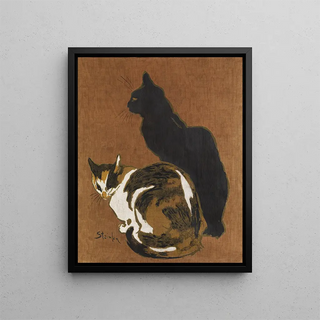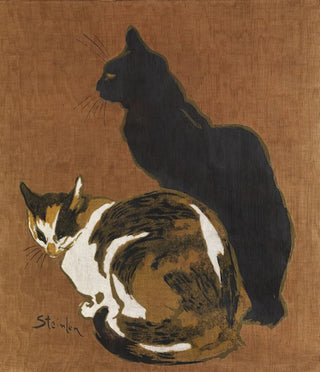Art print | Two cats - Théophile Alexandre Steinlen


View from behind

Frame (optional)
Deux cats - Théophile Alexandre Steinlen – Captivating introduction
In the fascinating universe of art, some works manage to capture not only a moment but also the essence of an era. "Deux cats" by Théophile Alexandre Steinlen is one of those creations that evoke both tenderness and melancholy. Painted at the end of the 19th century, this artwork immerses us in a Parisian atmosphere filled with charm, where felines become symbols of urban life. The depicted scene, with its two cats posed in a tranquil posture, invites gentle and introspective contemplation. Steinlen succeeds in transcending the simple animal portrait to offer a reflection on solitude and complicity, universal themes that still resonate today.
Style and uniqueness of the work
Steinlen's style is characterized by a delicate and sensitive approach, blending realism with touches of imagination. In "Deux cats," the outlines of the animals are delicately sketched, while the chosen colors evoke a soft and soothing palette. Shades of brown and cream, combined with subtly worked shadows, create a warm atmosphere. The cats, although depicted with a certain realism, seem almost endowed with a mystical aura, as if they were guardians of a secret only initiates could understand. The composition, with its harmonious balance, captures the eye and invites viewers to linger on the details, revealing the meticulousness of Steinlen's work. Every brushstroke tells a story, every exchanged glance between the felines suggests a silent complicity that transcends time.
The artist and his influence
Théophile Alexandre Steinlen, born in Switzerland in 1859, found his place in the heart of Paris, where he established himself as a true witness of his era. An artist of many talents, he explored various mediums, from painting to advertising posters, including lithography. His work is often associated with Parisian bohemian life, where he captured the essence of the working classes and everyday moments. Steinlen was also a passionate advocate for animals, which is reflected in his affectionate portrayal of cats. His influence continues to

Matte finish

View from behind

Frame (optional)
Deux cats - Théophile Alexandre Steinlen – Captivating introduction
In the fascinating universe of art, some works manage to capture not only a moment but also the essence of an era. "Deux cats" by Théophile Alexandre Steinlen is one of those creations that evoke both tenderness and melancholy. Painted at the end of the 19th century, this artwork immerses us in a Parisian atmosphere filled with charm, where felines become symbols of urban life. The depicted scene, with its two cats posed in a tranquil posture, invites gentle and introspective contemplation. Steinlen succeeds in transcending the simple animal portrait to offer a reflection on solitude and complicity, universal themes that still resonate today.
Style and uniqueness of the work
Steinlen's style is characterized by a delicate and sensitive approach, blending realism with touches of imagination. In "Deux cats," the outlines of the animals are delicately sketched, while the chosen colors evoke a soft and soothing palette. Shades of brown and cream, combined with subtly worked shadows, create a warm atmosphere. The cats, although depicted with a certain realism, seem almost endowed with a mystical aura, as if they were guardians of a secret only initiates could understand. The composition, with its harmonious balance, captures the eye and invites viewers to linger on the details, revealing the meticulousness of Steinlen's work. Every brushstroke tells a story, every exchanged glance between the felines suggests a silent complicity that transcends time.
The artist and his influence
Théophile Alexandre Steinlen, born in Switzerland in 1859, found his place in the heart of Paris, where he established himself as a true witness of his era. An artist of many talents, he explored various mediums, from painting to advertising posters, including lithography. His work is often associated with Parisian bohemian life, where he captured the essence of the working classes and everyday moments. Steinlen was also a passionate advocate for animals, which is reflected in his affectionate portrayal of cats. His influence continues to






